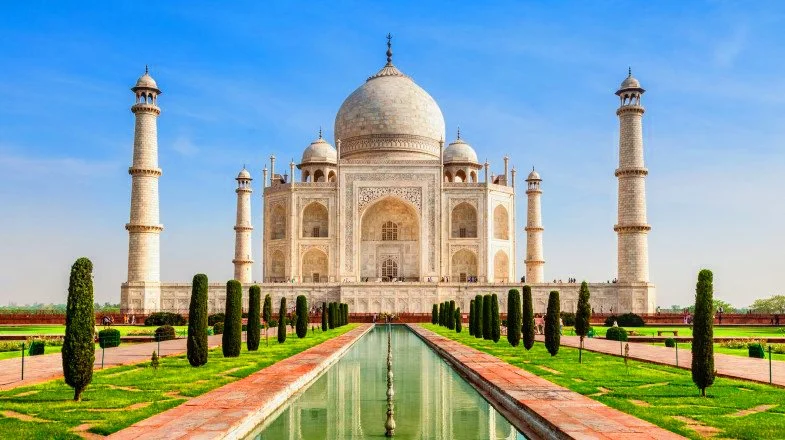Taj Mahal History
Taj Mahal is recognized as one of the wonders of the world and the United Nations Educational, Scientific and Cultural Organization (UNESCO) is considered a world heritage site. The Taj Mahal is present in Agra (Uttar Pradesh) and has stunning architecture with a rich history behind it.
Taj Mahal History
What is the Taj Mahal? The Taj Mahal is actually the tomb of Mumtaz Mahal. She was the beloved wife of Emperor Shah Jahan of the Mughal Empire. When Mumtaz Mahal died during childbirth, Shah Jahan felt huge grief and then decided he would make a great palace as the last resting place of his beloved wife.
This project was started in 1632 on the order of Shah Jahan. It took almost two decades to complete this masterpiece. When we take a look at why and how the Taj Mahal was constructed we come to know it was a pure symbol of love and architectural brilliance and it still stands tall as a symbol of love.
Design and Construction of the Taj Mahal
The marble and semi-precious stones such as jade, crystal, lapis lazuli, amethyst, and turquoise have been used in the Taj Mahal Construction. The Taj Mahal was constructed by using the technique of pietra dura. Besides the Central main Dome, it has four more domes around the main dome. The main dome’s height is 240 feet (73 meters). It also has four minarets.
The Construction of the Taj Mahal architecture gave the Islamic touch as the Quranic passages were calligraphed on the entrances and various other parts of the complex by skilled workers. The Taj Mahal’s primary entrance was constructed from red sandstone and there is a square garden which is divided by a row of water pools. There is also a red sandstone mosque that is in an identical position to the garden and this structure is called a “jawab”.
The room or place where Mumtaz Mahal’s symbolic tomb has been decorated with semi-precious stones. Her actual grave is right under her symbolic grave.
What does the Taj Mahal Represents?
The Taj Mahal represents several concepts including
- Love
- Architecture Brilliance
- Rich History
- Islamic Culture
- MIndblowing Beauty
- Symbolism
- Heritage
- Artistry
- Engineering Brilliance
- Legacy
Features of the Taj Mahal
The Taj Mahal has several remarkable features including:
Architectural Magnificence
The structure is famous for its symmetrical design, delicate marble inlays, and decorative elements made by skilled workers.
Marble Mausoleum
Mumtaz Mahal’s tomb, the tomb of Shah Jahan made of beautiful pure white marble.
Decorative Elements
Several decorative elements such as elegant calligraphy, geometric patterns, and ornamental motifs have been used during its construction.
The Gardens
There are four gardens that have classic designs with a central structure also having long pools of water, trees, fountains, and pathways.
Dome and Minarets
There are five in total domes. With one main dome, there are four other small domes and four minarets too on its main structure.
Pietra Dura Inlays
The whole main structure is crafted from semi-precious stones and its marble surfaces, show the mastery of Mughal craftsmanship.
How to Get There?
Agra, the prominent and world’s famous city of Uttar Pradesh due to the Taj Mahal is hosting visitors since the Taj Mahal was constructed. According to a survey around eight million people from the whole world come to see the Taj Mahal every year. The Taj Mahal is easily accessible as buses and trains are always available for Agra. Access to the Taj Mahal complex is by foot.
Main Things to See
When visiting the Taj Mahal, some of the main things to see and experience are:
The Main Gateway
Praise the beautiful and impressive structure of the main entrance leading towards the Taj Mahal.
The Gardens
There are beautiful gardens around the Taj Mahal which are divided into quadrants by water channels.
The Mosque
It is recommended for Muslim visitors to explore The Mosque which is constructed by red sandstones.
The Guest House (Mehman Khana)
Right identical to the Mosque there is a guest House one must explore this place.
The Yamuna River
Taj Mahal is situated on the bank of the Yumna River so plz do not miss the picturesque scenery of this river.
The Marble Inlay Work
Marble of different colors has been used for the construction of the Taj Mahal and you can also find calligraphy throughout this brilliant structure.
The Reflection Pool
There are several rectangular pools in front of the Taj Mahal main building that increase the beauty of this wonder
The Interior
The Interior of the whole monument is brilliant and breathtaking and the mouth speaks evidence of this masterpiece.
The Calligraphy
The Quranic passages and verses have been calligraphed by the most skilled persons of that time. It is worth watching to see that beautiful art.
Current Issues
With all of its characteristics the Taj Mahal is facing some issues e.g. it is an almost four hundred years old building which is why needs to fix some sort of wear and tear every year. Moreover, due to air and water pollution, the marble color has been fainted. Additionally, The Taj Mahal also facing Environmental Degradation, Deterioration Due to Tourism, Heritage Management, and kind of Political Controversy issues that should be resolved on an urgent basis.
Final Words
In the end, I must say the Taj Mahal is a complete masterpiece of love, beauty, architecture, and engineering. Though it is facing some environmental challenges, it is still entertaining tourists with its breathtaking beauty.




